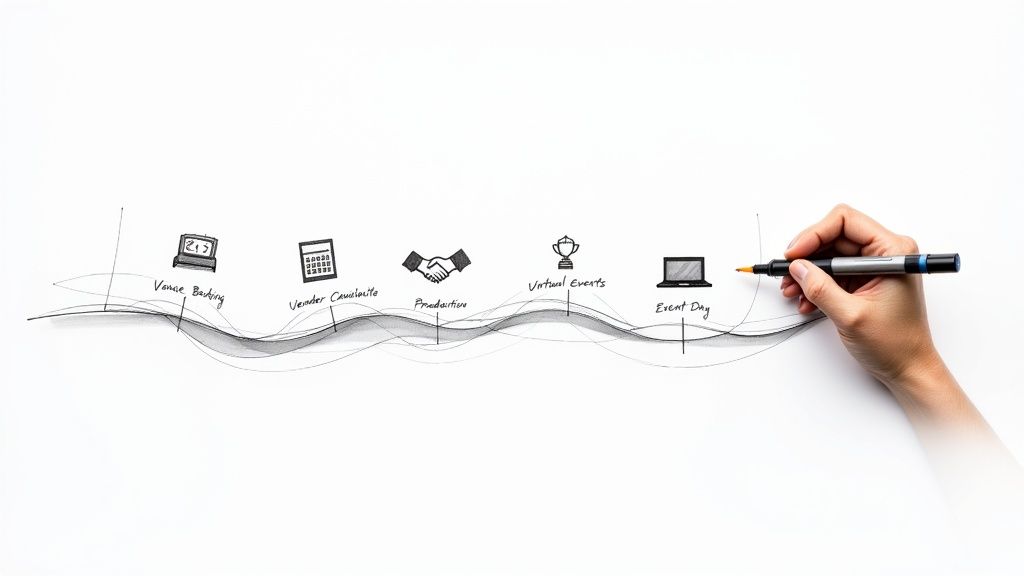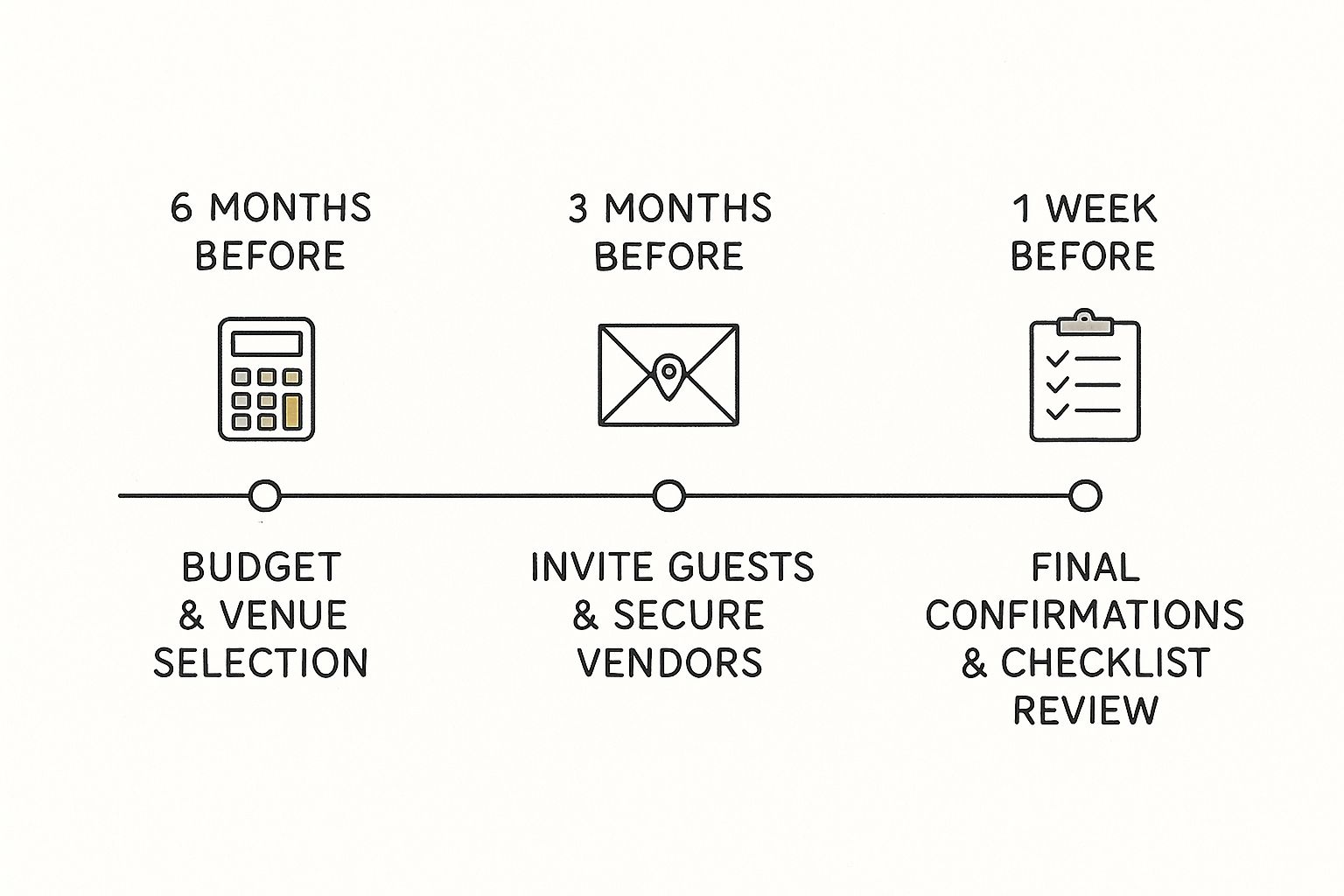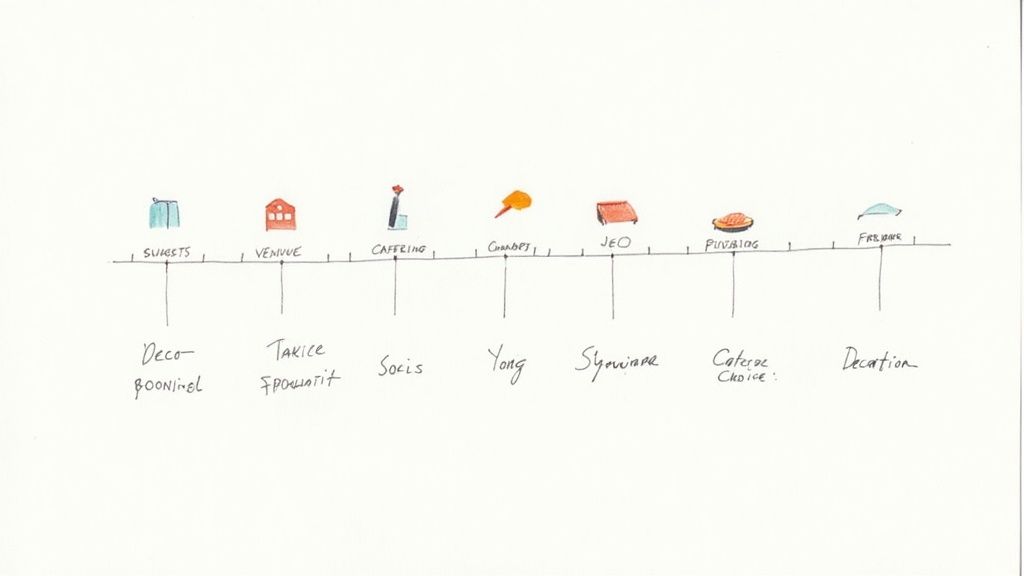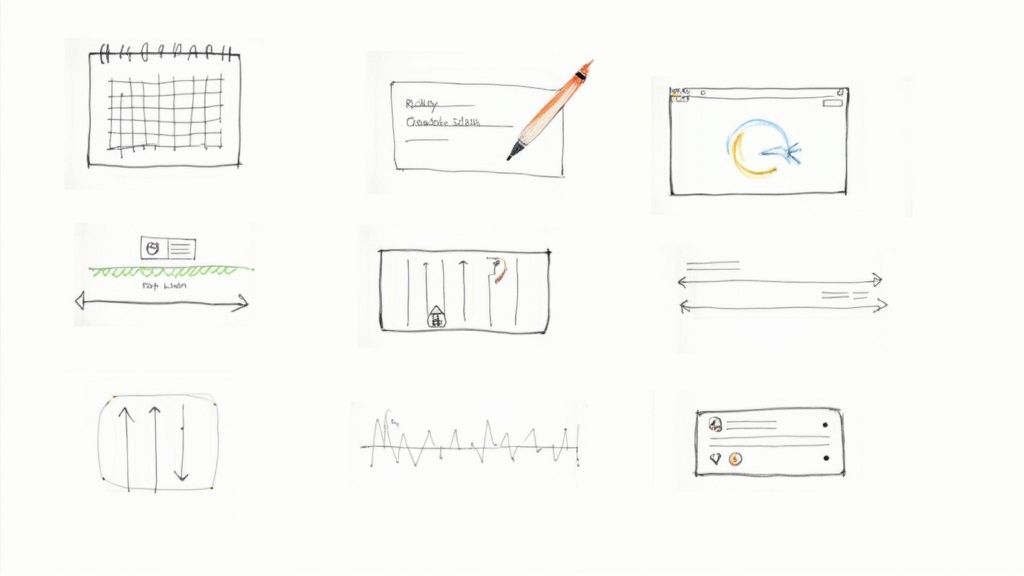August 15, 2025

Think of an event planning timeline template as your strategic blueprint. It’s the master plan that lays out every single task, deadline, and milestone, taking you from that first lightbulb moment all the way through to the post-event wrap-up. This isn't just about making a list; it’s the critical project management tool that turns a massive, complex event into a series of calm, manageable steps.

It’s tempting to think of an event timeline as just a glorified to-do list, but that seriously undersells its power. That's like calling an architect's blueprint just a drawing. A truly well-built timeline is the strategic backbone that keeps your event from spiraling into chaos.
It's your command center for communication, your early warning system for risks, and your best friend for protecting the budget. Let's dig into why it’s so much more than a simple checklist.
Picture this: you're planning a huge corporate product launch. You've got marketing, sales, IT, and logistics teams all working internally. On top of that, you're juggling external vendors for catering, AV, and the venue. Without one shared timeline, things get messy, fast.
Marketing might schedule a social media blitz before the final press release is even approved. The venue could accidentally double-book your setup day. A detailed timeline acts as a single source of truth, eliminating these headaches. Everyone sees the same deadlines and, crucially, understands how their work impacts everyone else. This transparency keeps the entire team in sync and accountable.
A timeline isn't just about scheduling tasks; it's about sequencing success. It ensures that every stakeholder—from your internal team to external vendors—is moving in concert toward a unified goal.
A good timeline forces you to think ahead, which is the heart of managing risk. When you map out your entire event months in advance, you can spot potential problems before they happen. For example, you’ll see right away that you need to book that high-demand keynote speaker 10-12 months out, long before you're left scrambling.
This foresight is also a huge budget-saver. Last-minute decisions are almost always more expensive. We've all been there—paying for rush-printed banners or expedited shipping because something was forgotten. A timeline builds in plenty of breathing room for every purchase and decision, preventing that kind of panic spending. While the timeline is key, it's just one part of effective event planning that leads to success.
With the global events industry projected to hit $2.5 trillion by 2035, staying organized is more important than ever. It's no surprise that 79% of event professionals now rely on systems to manage their workflows. A solid timeline isn't just a nice-to-have; it's a necessity.
Looking at a blank calendar when you're starting to plan an event can be pretty intimidating. But I'll let you in on a little secret that every experienced planner lives by: work backward. Start with the actual date of your event and then map out all the critical deadlines in reverse. It's the best way to turn a massive, overwhelming project into a series of smaller, much more manageable tasks.
This whole reverse-engineering trick isn't just about making a to-do list; it's a strategic way to make sure nothing falls through the cracks. When you lock in those major milestones first, you build a solid framework that guides every other decision. It creates clarity and momentum right from the start, which is your best defense against that last-minute scramble.
This is where you lay the groundwork. Long before you're thinking about things like floral arrangements or playlists, you have to get the non-negotiables sorted out. The decisions you make now will set the stage for everything that follows.
Here's what should be at the top of your list:

As you can see, the early game is all about those big, foundational pieces like securing a budget and venue. As you get closer to the event, your focus naturally shifts to the finer details and execution.
To give you a clearer picture, I've broken down the typical event lifecycle into a simple table. Think of this as a flexible blueprint you can adapt for anything from a corporate conference to a large-scale wedding.
This structure helps visualize how your priorities shift over time, moving from broad strategy to meticulous, on-the-ground details.
With your foundation firmly in place, it's time to start bringing the vision to life and, just as importantly, getting people excited about it. This is usually the busiest stretch, filled with vendor coordination and marketing activities. Your timeline here should be granular, with specific action items for promotion and logistics. If you need a deeper dive into the overall process, exploring broader concepts in https://groupos.com/blog/event-management-planning can offer some great insights.
During this period, you’ll be juggling contracts, rolling out promotional campaigns, and fine-tuning the attendee experience. For example, if you’re putting together a virtual event, a comprehensive webinar planning checklist is an absolute lifesaver for making sure all the technical and marketing bases are covered.
Welcome to the home stretch! This last phase is all about locking in the final details and prepping for a flawless on-site (or online) experience. Communication becomes your most important tool now. You'll be chasing down final RSVPs, confirming arrival times with every vendor, and building out hyper-detailed schedules for the event day.
Your timeline's final month should be less about making big decisions and more about triple-checking them. This is when you create contingency plans and ensure every team member knows their exact role.
Here are a few of the critical tasks to tick off as you approach the finish line:
When you break the entire process down like this, that intimidating timeline transforms into a clear, step-by-step roadmap for a successful event.

When you’re planning a virtual or hybrid event, the old rules don't quite apply. While the core concept of working backward from the event date still holds, you're suddenly juggling a whole new set of tasks—ones that are deeply rooted in technology and digital content. A generic timeline template simply won’t cover all your bases.
You need to build in milestones that are specific to the digital experience. It's not just about emailing a meeting link; you're crafting an entire online environment from scratch. This demands a different kind of planning and a timeline that prioritizes tech from day one.
One of the biggest shifts is how early you need to lock down your technology. For a virtual event, the platform is the venue. Just like a physical hotel ballroom, the best platforms get booked up or require a lot of lead time for integration and setup.
Your timeline has to make room for these digital-first tasks:
A hybrid event isn't just one event; it's two distinct experiences running in parallel. Your timeline must reflect this duality, managing both in-person logistics and virtual production simultaneously.
Let's say you're planning a large hybrid conference. You're essentially managing two timelines that have to sync up perfectly at key moments.
One timeline track is for the in-person experience: booking the venue, finalizing catering, planning the floor layout, and managing on-site registration. The other track is entirely for the virtual side: managing the livestream production, setting up online networking spaces, and training digital support staff.
A solid hybrid timeline template shows exactly where these two worlds collide. For example, the schedule for the on-site A/V team has to align perfectly with the virtual platform's streaming technicians. Speaker prep suddenly involves both an on-stage soundcheck and a separate virtual tech check from their home office.
Don't forget the added complexity of coordinating across different time zones for your remote speakers and attendees. Always build extra buffer time into your schedule for these international touchpoints. For more on this, our guide on 7 virtual event best practices can help you anticipate some of the unique challenges.
Getting this right is a big deal financially. The virtual event market is expected to surge to $537.18 billion by 2029. That's partly because virtual formats can cost 75% less than their in-person counterparts while often improving lead capture. Nailing your digital timeline is how you tap into that potential.
Finally, your work isn't done when the event ends. A good timeline includes post-event tasks like editing and uploading on-demand content, sending out access links for virtual attendees, and digging into the digital engagement data. For virtual and hybrid events, this follow-up phase is just as important as the event itself.
Let's be honest: the idea of a one-size-fits-all event planning timeline is a fantasy. Anyone who's been in the trenches knows that the timeline for a massive corporate conference shares very little DNA with the plan for a multi-day music festival or a private wedding. A great master template is your starting point, but its real value is unlocked when you know how to mold it to the unique demands of each event.
The secret is learning to spot the non-negotiable, long-lead-time items that define that specific event. For a music festival, your entire plan will hinge on locking in artists, navigating stage production logistics, and securing a mountain of permits—often a year or more in advance. These tasks aren't just line items; they are the bedrock of your entire schedule.
Now, picture a corporate conference. The critical path looks completely different. Here, your first moves are almost always about securing big-name keynote speakers and finalizing sponsorship deals. Why? Because those elements are what drive your marketing, fill seats, and fund the whole operation. Your timeline has to reflect this business-first focus right from day one.
And then there's a wedding, where everything is intensely personal. The major milestones aren't about ROI, but about emotion and personal deadlines. Sending invitations, scheduling dress fittings, and locking in that perfect menu tasting are the make-or-break moments. This calls for a timeline that’s both organized and deeply empathetic to the human element.
The real skill in timeline management isn't finding one perfect template. It's knowing how to reshuffle the deck—re-prioritizing your master list to align with the unique goals and critical path of whatever event is in front of you.
This need for specialized timelines is backed by real numbers. With conference and corporate events making up a massive 62% and 61.2% of the market, respectively, getting this right is crucial. At the same time, the music concert category is growing at a blistering 13.1%, proving that different event types require completely different playbooks. As 41% of professionals report hosting more events than ever, an adaptable template isn't a "nice-to-have"—it's essential for survival. You can dig into more data on these trends in this detailed industry report.
To really see how these priorities clash in the real world, it helps to put them side-by-side. The table below breaks down where you should focus your energy—and when—for a few common event types.
As you can see, while booking a venue is a common thread, the other top priorities couldn't be more different. For example, when you're deep in the weeds of planning a trade show, a task like learning how to Master Trade Show Lead Capture Techniques becomes a high-priority item that needs its own dedicated spot on your schedule.
By pinpointing these unique critical tasks from the get-go, you can transform a generic template into a powerful, tailor-made roadmap that sets every event up for success.

Look, a spreadsheet is a perfectly fine place to start mapping out your event. But if you stop there, you’re basically bringing a hand-drawn map to a race that everyone else is navigating with GPS. To really make your event planning timeline work for you, you need to bring it to life with digital tools.
The right software elevates your timeline from a static checklist into a living, breathing command center for your event. This is where you go from just listing tasks to actively managing them, which is absolutely critical for sidestepping the communication breakdowns and blown deadlines that can sink an otherwise great event.
For a lot of events, a general project management platform like Asana or Trello hits that sweet spot between flexibility and raw power. They are brilliant for laying out your timeline visually, delegating tasks to specific team members, and attaching firm deadlines.
Let's say you're organizing a corporate retreat. In Asana, you could create a "Finalize Activity Schedule" task and assign it to your program manager. Better yet, you can create task dependencies. This means the "Book Transportation for Offsite Activities" task can't even begin until the schedule is locked in, which builds a logical, almost foolproof workflow right into your plan.
When you’re dealing with a large-scale or particularly complex event, a specialized event management platform can be a total game-changer. I’m talking about tools like Cvent, which are purpose-built for the event world. They handle the entire lifecycle, from registration and ticketing all the way through to attendee engagement apps and post-event analytics.
Think of it this way: Trello is a fantastic multi-tool—versatile and great for all sorts of jobs. Cvent is the specialized, industrial-grade equipment designed to do one thing flawlessly: run a massive event. A good first step is to explore the essential event management software features to figure out what level of firepower you actually need.
The real magic of any good tool is creating a single source of truth. When your venue manager, marketing lead, and AV crew are all looking at the same real-time dashboard, you instantly kill the endless email chains and version control chaos that plague so many planning teams.
So, how do you choose? It really boils down to the scale and complexity of what you're planning.
No matter which path you take, the most important step is moving beyond a simple, static document. When you adopt a dynamic tool, you empower your team with automated reminders, clear progress tracking, and easy collaboration. Your timeline becomes a living guide that adapts with you, not a forgotten file buried in a folder somewhere.
Even with a killer template, you're going to have questions once you're in the thick of planning. It's just the nature of the beast. Learning to manage the subtle details of a timeline is a skill you build over time, but getting solid answers to common roadblocks can be a lifesaver.
Let's dig into a few of the questions I hear most often from other planners.
Honestly, it all comes down to the size and complexity of your event. There’s no single right answer, but there are definitely some reliable industry benchmarks that can point you in the right direction.
For a big production—think major conferences, trade shows, or a wedding with 200+ guests—you’ll want to start 12 to 18 months out. That might sound like a lot, but that lead time is what gets you the best venues and in-demand vendors before they’re snatched up by someone else.
If you’re planning a mid-sized corporate event or a regional summit for 50-200 people, a 6 to 9 month timeline usually works perfectly. For smaller events, like a local fundraiser or an internal company party, you can often pull it all together in just 2 to 4 months.
The golden rule? Your very first step, no matter the event size, should be checking venue availability. That date will be the anchor for your entire schedule.
The biggest mistake I see new planners make is underestimating how far in advance critical vendors book up. Your timeline template isn't just a checklist; it's a reality check that forces you to lock in those key decisions early.
The most common trap is treating the timeline as a "set it and forget it" document. That's a huge mistake. Your event plan is a living, breathing guide. It needs to be revisited and adjusted constantly as things inevitably change.
Another classic error is not building in any buffer time. Trust me, delays will happen. A supplier will miss a deadline, a key stakeholder will take forever to give an approval, or a storm will mess up travel plans. Without a cushion built around crucial deadlines—like when you have to submit your final headcount or send materials to the printer—one small hiccup can throw your entire plan into chaos.
Here’s a pro tip that has saved me countless times: review and adjust your timeline with your core team every single week. This forces you to keep the plan relevant and helps you spot potential problems before they become full-blown crises. It ensures your event planning timeline template stays a powerful tool, not just an outdated document.
Ready to stop juggling spreadsheets and start managing your events and community in one place? GroupOS offers an all-in-one platform to streamline ticketing, memberships, and communication, letting you focus on creating unforgettable experiences. Learn how GroupOS can transform your event management process.


